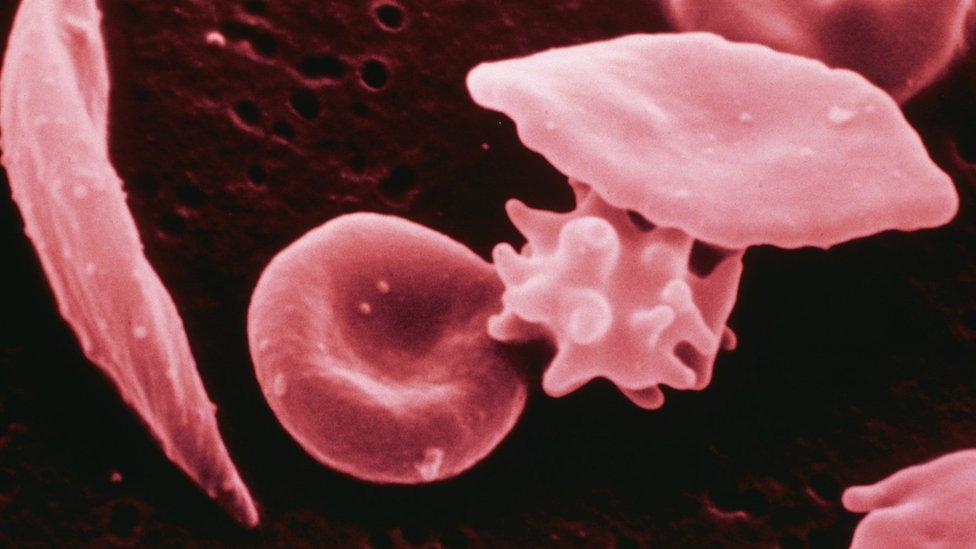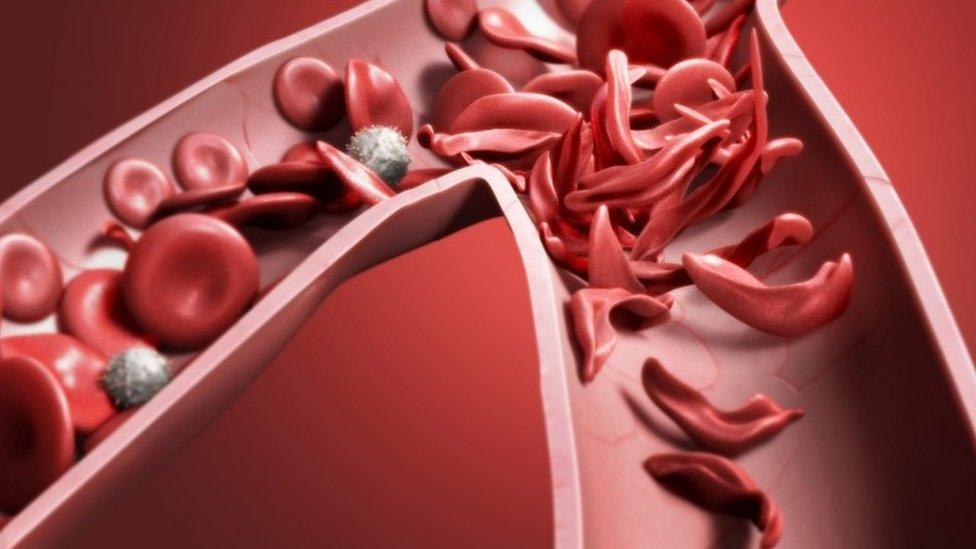Teenager's sickle cell reversed with world-first therapy
- Published

Healthy red blood cells are round, but the genetic defect makes them sickle shaped
A French teenager's sickle cell disease has been reversed using a pioneering treatment to change his DNA.
The world-first procedure at Necker Children's Hospital in Paris offers hope to millions of people with the blood disorder.
Scientists altered the genetic instructions in his bone marrow so it made healthy red blood cells.
So far, the therapy has worked for 15 months and the child is no longer on any medication.
Sickle cell disease causes normally round red blood cells, which carry oxygen around the body, to become shaped like a sickle.
These deformed cells can lock together to block the flow of blood around the body. This can cause intense pain, organ damage and can be fatal.
The teenager who received the treatment had so much internal damage he needed to have his spleen removed and his hips replaced.
Every month he had to go into hospital to have a blood transfusion to dilute his defective blood.
But when he was 13, doctors at the Necker Children's Hospital in Paris did something unique.
'No sign of disease'
Doctors removed his bone marrow - the part of the body that makes blood. They then genetically altered it in a lab to compensate for the defect in his DNA that caused the disease.
Sickle cell is caused by a typo in the instructions for making the protein haemoglobin, which is densely packed into red blood cells.
A virus was used to infect the bone marrow with new, correct instructions.
The corrected bone marrow was then put back into the patient.
The results in the New England Journal of Medicine, external showed the teenager has been making normal blood since the procedure 15 months ago.
Philippe Leboulch, a professor of medicine at the University of Paris, told the BBC News website: "So far the patient has no sign of the disease, no pain, no hospitalisation. He no longer requires a transfusion so we are quite pleased with that.
"But of course we need to perform the same therapy in many patients to feel confident that it is robust enough to propose it as a mainstream therapy."
'Given his life back'
Prof Leboulch is nervous about using the word "cure" as this is just the first patient to come through clinical trials.
But the study does show the potential power of gene therapy to transform the lives of people with sickle cell.
"I think it's very significant, essential they've given him his life back," said Dr Deborah Gill from the gene medicine research group at the University of Oxford.
She told the BBC: "I've worked in gene therapy for a long time and we make small steps and know there's years more work.
"But here you have someone who has received gene therapy and has complete clinical remission - that's a huge step forward."
However, the expensive procedure can only be carried out in cutting-edge hospitals and laboratories, while most sickle cell patients are in Africa.
The next big challenge will be to transform this pioneering science into something that really can help millions of people.
Follow James on Twitter, external.


What is sickle cell disease?
Sickle cell disease is a lifelong condition caused by a faulty gene that affects how red blood cells develop
SCD mainly affects people of African, Caribbean, Middle Eastern, Eastern Mediterranean and Asian origin
People with sickle cell are often at an increased risk of contracting serious infections or they could become anaemic, which is when red blood cells cannot carry enough oxygen around the body. This can cause tiredness and shortness of breath
Some patients have regular blood transfusions - usually every three to four weeks - as a form of treatment for the condition
Source: NHS Choices, external

- Published18 June 2016
